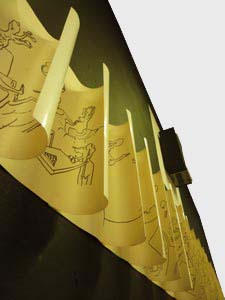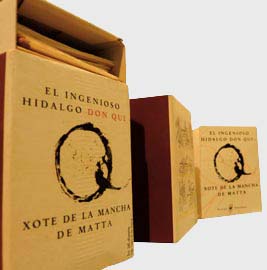Revolutionary par excellence, few have been the artists that have so ingeniously developed works so vast in their diversity, even in the eyes of the new millennium. Roberto Sebastian Matta approached art as one who bets on life. So much so, that the idea of the artist as the giver of light that emerges from the “development of the creative imagination, of an intelligence that can make use of poetic imagination, of subversive imagination, even of erotic imagination”;[i] that encouraged him to change plans and architecture for painting, for graphics, for the object.
And it is that for this little-big man/artist, creative freedom and fulfillment could only be achieved by fighting “against his internal tyrants: hypocrisy and fear”. What are if not his searches within the context of Surrealism, those that led him to question the “reality” with fresh, perceptive eyes? This Chilean by birth and universal by (ad)option, was also a communicator who liked to travel through language as one penetrates into the heart of things: from the visual field to the oral, and from there to writing.
 Words as a territory to be conquered by an etymological game, with humor and wisdom, is present in many of his works. Thus, the combination of text and image in some of his drawings and graphic proposals, can be seen as part of an concern that led him also to explore the book’s universe as an object of art, as a place for communication, creativity, enjoyment and knowledge.
Words as a territory to be conquered by an etymological game, with humor and wisdom, is present in many of his works. Thus, the combination of text and image in some of his drawings and graphic proposals, can be seen as part of an concern that led him also to explore the book’s universe as an object of art, as a place for communication, creativity, enjoyment and knowledge.
The homage paid by Casa de las Americas on the artist’s centenary, by means of the exhibition Matta: del arte al libro[ii] (Matta: from art to books), is part of the celebrations that several museums have been carrying out.[iii] La Casa, which in 2006 had already dedicated an entire year to this artist’s work,[iv] close friend of the institution and of Cuba, could not overlook such an important anniversary, and for this reason they selected a set of works that explore the of book-(art)object field, also known as “artist’s book”.
While it is true that everything that Matta set out to explore in art, he carried out, we are not amazed when we always find new angles from which to enjoy his work. The singularity of each composition selected from Matta: del arte al libro shows the paths he travelled, as well as the diversity of literary references that inspired him: from Cervantes to Antonin Artaud, by ways of Rabelais, or his contemporaries Alain Jouffroy and Daniel Ponmerculle.
Similarly, the volume Come detta dentro vo significando(1962), Matta launched his questions while also playing with words (“Venus-Venus”, “Conscience-fictions”), suggesting inherent meanings hidden between syllables, waiting to emerge to enlighten us. This book-object illustrated by a set of etchings of great beauty, resembles an inside look that the artist takes through both text and image into space, interior or imagined. In fact the represented figures float ethereally, motionless, like a spacecrafts from an undiscovered universe, waiting for something to propel them. All of them originating from an imaginary whose precedents can be traced to his works Intronautas (1965) and Emospheral (1973), or in the Series Oro (1965).
The exhibition also includes bibliographical rarities as the lithographic miniature: El Ingenioso Hidalgo Don Quixote de la Mancha (1991), in which Matta says: “(...) La verité on la trouve dans les détails, entre les lignes, dans les plis. Don Q. se plie en 8 pour vous la faire voir”. In this work, the Chilean artist uses the book-pocket accordion form, in order to tell «between the lines” through small color lithographs and scenes -like in cartoons or comics- of some of the of universal literary hero’s feats. Similarly, it is possible to appreciate the magnificence of large format from a composition such as La Araucana (1978), in which the artist’s iconography draws from the text and in turn enriches it. Indeed, lithographs share the limelight with the first song of the homonym poem written by Alonso de Ercilla y Zúñiga in 1569,[v] giving it color, vibrating in unison, in order to bring it closer to the solemn tone of the text written in Ancient Spanish.
On the other hand, the volume Garganta Tua(1981) Matta timidly explores what specialists call “paper engineering”, resource by which a creator makes a paper structure emerge from between two pages, with an attractive and ingenious visual effect, although punctual, especially for those who as he, approached this technique for the first time. Then again word play and humor to honor one of world literature’s greatest: François Rabelais and his Gargantúa y Pantagruel.
 However, Matta wanted to further explore the morphology of the book-object when he conceived the volume L’Abolition de l’art (1968). Here, he comes back to the idea of ancient manuscripts, merging it with the cartoon or comic strip, creating a type of art object that appeals to the viewer’s imagination in order to understand the narrated “story”. Story that, depending on where the visitor is located and how he interacts with the piece, can be understood through characters who “reflect” or not about themselves, or by finding clues here and there that guide us in finding the meaning, hidden letters in the drawings that form a message: “… un code réel. Un coup…”, generating new questions about art’s role in society, its power over “others”.
However, Matta wanted to further explore the morphology of the book-object when he conceived the volume L’Abolition de l’art (1968). Here, he comes back to the idea of ancient manuscripts, merging it with the cartoon or comic strip, creating a type of art object that appeals to the viewer’s imagination in order to understand the narrated “story”. Story that, depending on where the visitor is located and how he interacts with the piece, can be understood through characters who “reflect” or not about themselves, or by finding clues here and there that guide us in finding the meaning, hidden letters in the drawings that form a message: “… un code réel. Un coup…”, generating new questions about art’s role in society, its power over “others”.
Extended like book leaves on the walls of the gallery, each volume talks to the space in a natural, particular way. In fact, the curatorship, in hands of the curator and restaurateur Yoani Rivera Victores, does not presuppose a chronological order, but attempts to highlight characteristic aspects and features of each composition, which leads the viewer to delve into centuries of history and culture, in a short period of time. While reproducing one of the images in a large format (Come detta dentro vo significando) with three-dimensional elements, or the surprise of finding some of the characters joyfully “dwelling” both on the paper and on the walls of the gallery, inviting us to go on seeking another vision of the world.
Matta: del arte al libroin the vortex, is where creation, pleasure and knowledge come together to explore and travel through the vast Cultural universe (in capital letters), something that this creator professed and knew how to nurture in others.
[i] ROBERTO MATTA: “La guerrilla interior”. Remarks at the Cultural Congress, Havana, 1968.
[ii] Opened at the Latin American Gallery, December 5th, 2011, the exhibition coincided with the 33rd International Festival of New Latin American Cinema, whose image on this occasion was a work of the Chilean artist, to whom the Festival House also paid tribute with the presentation of several documentaries about his life.
[iii] A retrospective exhibition entitled Matta recently opened. Centenary 11/11/11 (Centro Cultural Palacio de la Moneda, Santiago de Chile, November, 2011), which included pieces from 1938 to 2002, from 28 museums and cultural centers around the world. In the show there are some works present from the Art Collection de Nuestra America of the Casa de las Americas.
[iv] The Matta Year took place from March 2006 to March 2007, and occupied all the exhibition spaces of the institution with pieces donated by the artist to La Casa during his travels to the island.
[v] This poem recounts the conquest of Chile, as well as customs and culture of the Arauca, the indigenous people who rebelled against the usurpation of their lands by the Spanish rule.
Related Publications

How Harumi Yamaguchi invented the modern woman in Japan
March 16, 2022












